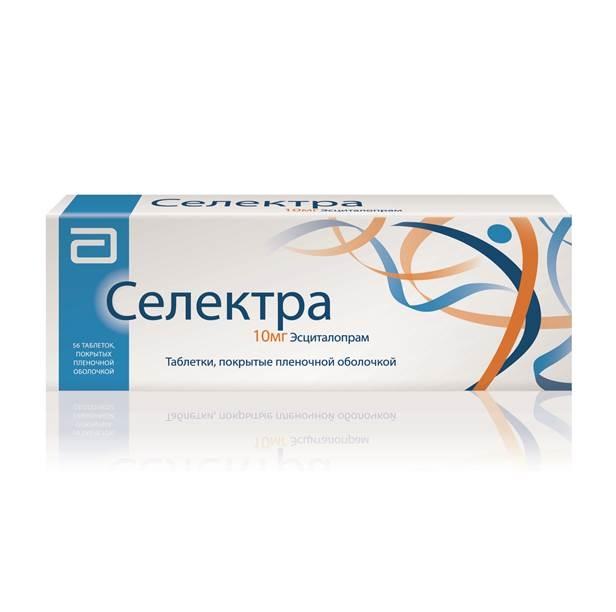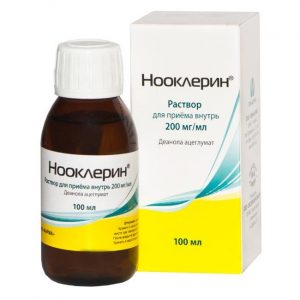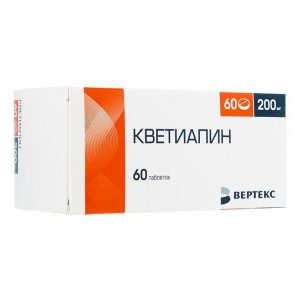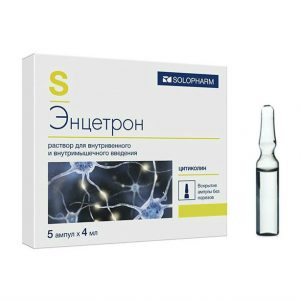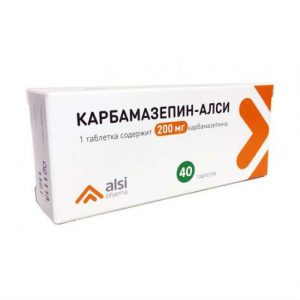Description
Latin name
SELECTRA
Release form
White film coated tablets, oval, biconvex, engraved with E on one side, risk on the other, and side risks.
Pharmacological action
antidepressant, selective serotonin reuptake inhibitor (SSRI). Inhibition of serotonin reuptake leads to an increase in the concentration of this neurotransmitter in the synaptic cleft, enhances and prolongs its effect on postsynaptic receptor sites.
Escitalopram does not have or has very poor ability to bind to a number of receptors, including: serotonin 5-HT1A-, 5-HT2 receptors, dopamine D1 and D2 receptors, 1-, 2-, -adrenoreceptors, histamine H1- receptors, m-cholinergic receptors, benzodiazepine and opioid receptors.
Indications
– depressive disorder of any severity
– panic disorder with / without agoraphobia.
Contraindications
– concomitant use with MAO inhibitors
– childhood (up to 15 years)
– pregnancy
– lactation (breastfeeding)
– hypersensitivity to the drug or its components.
Caution is advised to prescribe the drug for renal failure (CC below 30 ml / min), hypomania, manic disorders, pharmacologically uncontrolled epilepsy, depression with suicidal attempts, diabetes mellitus, cirrhosis of the liver, tendency to bleeding, while taking with drugs that reduce drugs the threshold of convulsive readiness that causes hyponatremia, with ethanol, with drugs metabolized by CYP2C19, as well as elderly patients and adolescents t 15 to 18 years.
Special instructions
Some patients with panic disorder may experience increased anxiety at the beginning of treatment with SSRIs. Such a paradoxical reaction usually disappears within two weeks of treatment. To reduce the likelihood of an anxiogenic effect, it is recommended to use the drug in a low initial dose.
The drug should be discontinued if convulsive seizures develop. It is not recommended that patients with uncontrolled epilepsy with controlled seizures need careful monitoring. With an increase in the frequency of convulsive seizures, SSRIs, including escitalopram, should be abolished.
Escitalopram should be used with caution in patients with a history of mania / hypomania. With the development of a manic state, escitalopram should be abolished.
In patients with diabetes, treatment with escitalopram can change the level of glucose in the blood (both hypoglycemia and hyperglycemia are possible). Therefore, dose adjustment of insulin and / or oral hypoglycemic drugs may be required.
The risk of suicide is inherent to depression and can persist until a significant improvement in the condition that occurs spontaneously or as a result of therapy. Careful monitoring of patients undergoing antidepressant treatment is necessary, especially at the beginning of treatment due to the possibility of clinical deterioration and / or the appearance of suicidal manifestations (thoughts and behavior). This precaution must be observed in the treatment of other mental disorders because of the possibility of the simultaneous development of depression.
In a number of cases, treatment with SSRI antidepressants showed an increased risk of suicidal thoughts and behavior in children, adolescents, and young people under 24 years of age compared with placebo.
Hyponatremia, possibly associated with impaired ADH secretion, rarely occurs with escitalopram and usually disappears when therapy is discontinued. Caution should be exercised when prescribing escitalopram and other SSRIs to people at risk of developing hyponatremia: the elderly, patients with cirrhosis of the liver and taking drugs that can cause hyponatremia.
When taking escitalopram, subcutaneous hemorrhages (ecchymosis and purpura) may develop. It is necessary to use escitalopram with caution in patients with a tendency to bleeding, as well as taking oral anticoagulants and other drugs, affecting blood coagulation.
Since clinical experience with the use of escitalopram and electroconvulsive therapy is limited, caution should be exercised in such cases.
Combining escitalopram and type A MAO inhibitors is not recommended due to the risk of developing serotonin syndrome.
In patients taking escitalopram and other SSRIs concurrently with serotonergic drugs, in rare cases, serotonin syndrome may develop. It is necessary to use escitalopram with caution simultaneously with drugs that have a serotonergic effect. A combination of symptoms such as agitation, tremor, myoclonus, hyperthermia, may indicate the development of serotonin syndrome. If this happened, SSRIs and serotonergic drugs should be immediately canceled and symptomatic treatment prescribed.
Influence on the ability to drive vehicles and control mechanisms
During treatment with the drug, patients should avoid performing potentially hazardous activities that require high speed psychomotor reactions, such as driving a car or operating machinery.
Composition
1 tab.
escitalopram oxalate 12.78 mg,
? which corresponds to the content of escitalopram 10 mg
Excipients: SMCC90 / HD90 prosolv – 147.42 mg (microcrystalline cellulose – 144.47 mg, silicon dioxide – 2.95 mg, 9% croscarmell sodium) magnesium stearate – 1.8 mg.
Film composition: Opadry white (Opadry 03F28446 White) ~ 5.4 mg: hypromellose 6cP – 3.29 mg, titanium dioxide – 1.31 mg, macrogol 6000 – 0.8 mg.
Dosage and administration
The drug is prescribed for adults and children over 15 years of age 1 time / day by mouth, regardless of food intake.
For depressive disorders, 10 mg 1 time / day is prescribed. Depending on the individual reaction of the patient, the dose can be increased to a maximum of 20 mg / day.
The antidepressant effect usually develops 2-4 weeks after the start of treatment. After the symptoms of depression disappear, for at least another 6 months it is necessary to continue therapy to consolidate the effect.
For panic disorders with / without agoraphobia, a dose of 5 mg / day is recommended during the first week of treatment, which then increases to 10 mg / day. Depending on the individual reaction of the patient, the dose can be increased to a maximum of 20 mg / day.
The maximum therapeutic effect is achieved approximately 3 months after the start of treatment. Therapy lasts several months.
Older patients (over 65 years of age) are advised to prescribe half of the usually recommended dose (i.e. only 5 mg / day) and a lower maximum dose (10 mg / day).
In renal failure of mild to moderate severity, dose adjustment is not required. Patients with severe renal insufficiency (CC below 30 ml / min) should be prescribed a drug with minimal therapeutic doses, gradually increasing them taking into account the tolerability and effectiveness of the drug.
In case of impaired liver function, the recommended initial dose for the first two weeks of treatment is 5 mg / day. Depending on the individual response of the patient, the dose may be increased to 10 mg / day.
For patients with weak CYP 2C19 isoenzyme activity, the recommended starting dose for the first two weeks of treatment is 5 mg / day. Depending on the individual response of the patient, the dose may be increased to 10 mg / day.
Upon termination of drug treatment, the dose should be gradually reduced over 1-2 weeks in order to avoid the occurrence of withdrawal syndrome.
Side effects
Side effects most often occur at 1 or 2 weeks of treatment, then usually become less intense and occur less frequently with continued therapy.
From the side of the central nervous system: dizziness, weakness, insomnia or drowsiness, convulsions, tremors, movement disorders, serotonin syndrome (agitation, tremors, myoclonus, hyperthermia), hallucinations, manic disorders, confusion, agitation, anxiety, depersonalization, panic attacks irritability, visual disturbances.
From the alimentary system: nausea, vomiting, dry mouth, taste disturbances, loss of appetite, diarrhea, constipation.
From the cardiovascular system: orthostatic hypotension.
From the endocrine system: decreased secretion of ADH, galactorrhea.
From the genitourinary system: decreased libido, impotence, impaired ejaculation, anorgasmia (in women), urinary retention.
Dermatological reactions: skin rash, itching, ecchymosis, purpura.
Allergic reactions: angioedema, anaphylactic reactions.
On the part of laboratory parameters: hyponatremia, a change in laboratory parameters of liver function.
Other: excessive sweating, hyperthermia, sinusitis, arthralgia, myalgia.
In addition, after prolonged use, a sharp discontinuation of Selectra therapy in some patients can lead to withdrawal syndrome. With a sharp cessation of taking escitalopram, undesirable reactions such as dizziness, headaches and nausea may occur, the severity of which is insignificant, and the duration is limited.
Drug Interactions
Serious adverse reactions may occur while taking Selectra and MAO inhibitors, as well as taking MAO inhibitors in patients who have stopped taking the drug shortly before. In such cases, serotonin syndrome may develop.
Escitalopram cannot be prescribed simultaneously with MAO inhibitors. Escitalopram can be prescribed 14 days after discontinuation of treatment with irreversible MAO inhibitors and at least 1 day after discontinuation of therapy with a reversible MAO inhibitor of type A – moclobemide. At least 7 days should elapse after taking escitalopram before treatment with non-selective MAO inhibitors can begin.
Co-administration with serotonergic drugs (e.g. tramadol, sumatriptan and other triptans) can lead to the development of serotonin syndrome.
Selectra may lower the seizure threshold. Caution should be exercised while prescribing with other drugs that lower the threshold of convulsive readiness (tricyclic antidepressants, other SSRIs, antipsychotics (phenothiazines, derivatives of thioxanthene and butyrophenone), mefloquine and tramadol).
Escitalopram enhances the pharmacological effects of tryptophan (increased serotonergic effect) and toxic effects of lithium preparations.
The simultaneous administration of escitalopram and preparations containing St. John’s wort (Hypericum perforatum) can lead to an increase in the number of side effects.
Violation of blood coagulability can occur with the simultaneous administration of escitalopram with oral anticoagulants and other drugs that affect blood coagulability (for example, atypical antipsychotics and phenothiazines, most tricyclic antidepressants, acetylsalicylic acid dipyridamide and dipyridamide). In such cases, monitoring of blood coagulation parameters is necessary.
Escitalopram does not enter into pharmacodynamic or pharmacokinetic interaction with ethanol. However, as with other psychotropic drugs, the simultaneous use of escitalopram and alcohol is not recommended.
Effect of other drugs on the pharmacokinetics of escitalopram
Co-administration with drugs that inhibit CYP2C19 may increase the concentration of escitalopram in the blood plasma. Caution should be exercised while using escitalopram with similar drugs, for example, omeprazole. A dose reduction of escitalopram may be required.
Precautions should be given escitalopram in high doses at the same time as cimetidine, which is a strong inhibitor of the isoenzymes CYP2D6, CYP3A4 and CYP1A2, in high doses.
Effect of escitalopram on the pharmacokinetics of other drugs
Escitalopram is an inhibitor of the CYP2D6 isoenzyme. Caution should be exercised while prescribing escitalopram and drugs that are metabolized with this isoenzyme and have a low therapeutic index, for example, flecainide, propafenone and metoprolol (in cases of heart failure) or medications that are mainly metabolized by CYP2D6 and acting on the central nervous system for example, antidepressants – desipramine, clomipramine, nortriptyline or antipsychotics – risperidone, thioridazine, haloperidol. In these cases, a dose adjustment may be required, as the concentration of escitalopram in the blood plasma increases.
The simultaneous administration of escitalopram and desipramine or metoprolol leads to a twofold increase in the concentration of the last two drugs, which should be considered when choosing doses.
Escitalopram may slightly inhibit the CYP2C19 isoenzyme. Therefore, caution is advised while using escitalopram and drugs metabolized by CYP2C19.
Overdose
Symptoms: dizziness, tremor, agitation, drowsiness, eclipse, convulsions, tachycardia, ECG changes (change in ST segment, T tooth, QRS extension, QT extension), arrhythmia respiratory depression, vomiting, rhabdomyolysis, metabolic acidosis, hypokalemia, very rarely – acute renal failure.
Treatment: symptomatic and supportive: gastric lavage, adequate oxygenation. Monitoring of cardiovascular and respiratory function. There is no specific antidote.
Storage conditions
The product should be stored out of the reach of children at a temperature not exceeding 25 ° C.
Shelf life
24 months.
Deystvuyushtee substance
stsitalopram
Terms and conditions
prescription
Dosage form
tablets
Possible product names
Selectra tablets coated film 10 mg 56 pcs.
